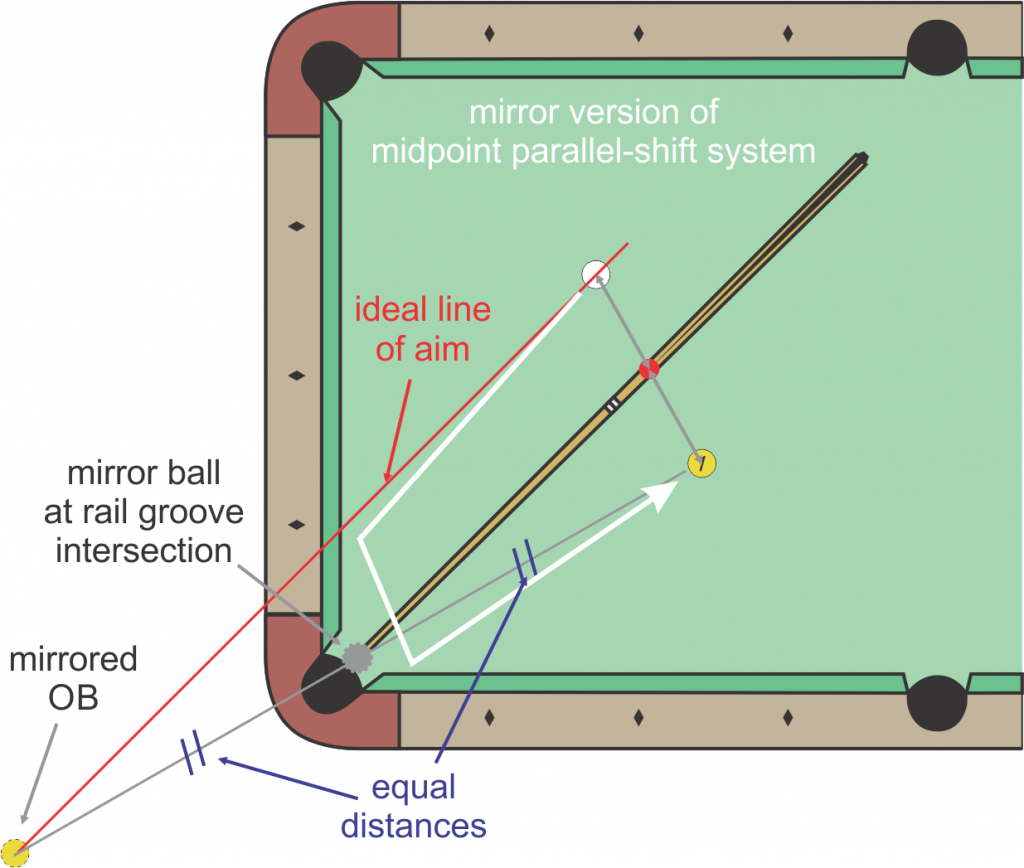Is there a reliable way to aim two-rail kick shots?
Yes. See the following video demonstrates the midpoint-parallel-shift system:
Unfortunately, the action of this shot depends on sidespin, shot speed, angle, ball distances, and table (especially cushion) conditions. Obviously, when practicing, you need to try to use consistent sidespin and speed on a given table to see how the cue ball responds at different angles. Here’s a summary of the adjustments required to compensate for different effects, as demonstrated in the video above:
Effects Summary
- general:
- slow or fast speed go short, so aim farther from pocket
- OB close to cushion goes short, so aim farther from pocket
- OB far from cushion goes long, so aim closer to pocket
- diagonal (45˚) approach into 1st rail:
- benchmark speed and spin give square hit
- less spin goes long, so aim closer to pocket
- more spin goes short, so aim farther from pocket
- shallower angle into 1st cushion (steeper angle into 2nd cushion) goes long
- aim closer to pocket or use less spin
- steeper angle into 1st cushion goes short
- aim farther from pocket or use less spin
For more information and demonstrations, see Shots 514 and 515 on Vol. IV of the Video Encyclopedia of Pool Shots.
If you want to be more accurate finding the midpoint between the balls, you can use your cue to measure one side and compare it to the other to make adjustments if necessary. Here’s an example:
The midpoint parallel-shift system can also be used for 2-rail bank shots, measuring between the OB and the target pocket. But with no or less running spin on the OB (even though you can impart a little with spin transfer), the OB will tend to go long, especially when coming into the 1st rail steep. But appropriate aim adjustments can be made. There is also a midpoint-parallel-shift system for aiming 1-rail kick and bank shots. It is covered on the mirror-system resource page. And there is also a midpoint-parallel-shift system for aiming cut shots.
If you have trouble parallel-shifting accurately, you can also use the method below suggested by Peter Ho on Facebook:

And if you have also have trouble estimating the midpoint, another alternative is to use your cue to measure the distance from the OB to the pocket (at the rail groove intersection), mirror or extend this distance beyond the table, and sight back to the CB to find the aim point on the rail. This approach is similar approach to the mirror technique used for 1-rail kicks.
from Patrick Johnson:
You have to aim a little closer to the corner than the measurement suggests – experience will tell you how much, depending on the angle to the first rail and the cleanliness of the table/balls.
In this drawing the blue line is the measured track, but the actual track will look more like the red line:

from Bob_Jewett:
… the “Amazing Double-mirror Image Method” or ADIM for short … is explained on the second page of http://www.sfbilliards.com/articles/2004.pdf (July). Mostly, it gives you a very easy way to put up a target ball exactly where the real ball would appear for a perfect mirror system. … This lets you see immediately how pitifully awful the two-rail mirror system is, but it also allows you to try to find out where it does work and maybe how to modify it so it works for more cases.
from dr_dave:
Here’s an illustration of the mirror version of the midpoint-parallel shift system mentioned in Bob Jewett’s article above:

Dr. Dave keeps this site commercial free, with no ads. If you appreciate the free resources, please consider making a one-time or monthly donation to show your support:
